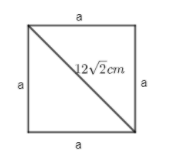
If a diagonal of a square is $12\sqrt{2}cm$ , then the perimeter of the square is _____.
(a) 24 cm
(b) $24\sqrt{2}cm$
(c) 48 cm
(d) $48\sqrt{2}cm$
Answer
580.5k+ views
Hint: Here, we will assume the length of the side of the square to be ‘a’ cm. Then we will use the formula $d=\sqrt{2}a$ where d is diagonal and ‘a’ is side of side. On putting values and solving, we will get side of length. Then we will find its perimeter by using the formula $4\left( side \right)$ i.e. $4a$ . Thus, we will get the answer.
Complete step-by-step answer:
Here, we will first draw the diagram of square with diagonal $12\sqrt{2}cm$ and having sides ‘a’. So, we get as

Now, to find length of side of square there is formula $d=\sqrt{2}a$ where d is diagonal length and ‘a’ is length of side of square.
Using this formula, we will find the length of the side of the square. So, we get as
$d=\sqrt{2}a$
On putting values, we get as
$12\sqrt{2}=\sqrt{2}a$
On cancelling $\sqrt{2}$ from both sides, we get as
$12=a$
Thus, we got the length of the side of the square as 12cm.
Now, we have to find the perimeter of the square i.e. summation of length of all sides of the square which is written as $4\left( side \right)$ .
On substituting the values, we get as
$\Rightarrow 4\left( sides \right)=4a$
$\Rightarrow 4\times 12=48cm$
Thus, we get a perimeter of square as 48cm.
Hence, option (c) is the correct answer.
Note: Another approach to solve this is finding length of side of square using Pythagoras theorem given as ${{\left( side1 \right)}^{2}}+{{\left( side2 \right)}^{2}}={{\left( hypotenuse \right)}^{2}}$ . So, in our case we will get as ${{a}^{2}}+{{a}^{2}}={{\left( 12\sqrt{2} \right)}^{2}}$ . So, on solving we get the equation as $2{{a}^{2}}=144\times 2\Rightarrow {{a}^{2}}=144$ . Taking the square root we get the length of side as $a=12cm$ . Thus, we get the same length now we can solve the further with perimeter part which will give the same answer.
Complete step-by-step answer:
Here, we will first draw the diagram of square with diagonal $12\sqrt{2}cm$ and having sides ‘a’. So, we get as

Now, to find length of side of square there is formula $d=\sqrt{2}a$ where d is diagonal length and ‘a’ is length of side of square.
Using this formula, we will find the length of the side of the square. So, we get as
$d=\sqrt{2}a$
On putting values, we get as
$12\sqrt{2}=\sqrt{2}a$
On cancelling $\sqrt{2}$ from both sides, we get as
$12=a$
Thus, we got the length of the side of the square as 12cm.
Now, we have to find the perimeter of the square i.e. summation of length of all sides of the square which is written as $4\left( side \right)$ .
On substituting the values, we get as
$\Rightarrow 4\left( sides \right)=4a$
$\Rightarrow 4\times 12=48cm$
Thus, we get a perimeter of square as 48cm.
Hence, option (c) is the correct answer.
Note: Another approach to solve this is finding length of side of square using Pythagoras theorem given as ${{\left( side1 \right)}^{2}}+{{\left( side2 \right)}^{2}}={{\left( hypotenuse \right)}^{2}}$ . So, in our case we will get as ${{a}^{2}}+{{a}^{2}}={{\left( 12\sqrt{2} \right)}^{2}}$ . So, on solving we get the equation as $2{{a}^{2}}=144\times 2\Rightarrow {{a}^{2}}=144$ . Taking the square root we get the length of side as $a=12cm$ . Thus, we get the same length now we can solve the further with perimeter part which will give the same answer.
Recently Updated Pages
Master Class 8 Social Science: Engaging Questions & Answers for Success

Master Class 8 Maths: Engaging Questions & Answers for Success

Master Class 8 Science: Engaging Questions & Answers for Success

Class 8 Question and Answer - Your Ultimate Solutions Guide

Master Class 8 English: Engaging Questions & Answers for Success

Why are manures considered better than fertilizers class 11 biology CBSE

Trending doubts
What is BLO What is the full form of BLO class 8 social science CBSE

Citizens of India can vote at the age of A 18 years class 8 social science CBSE

Full form of STD, ISD and PCO

Right to vote is a AFundamental Right BFundamental class 8 social science CBSE

What is the difference between rai and mustard see class 8 biology CBSE

Summary of the poem Where the Mind is Without Fear class 8 english CBSE




